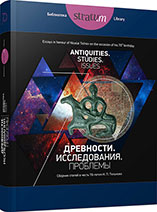Расписная керамика позднего энеолита на поселении Орловка-Картал на Нижнем Дунае
Late Eneolithic Painted Pottery at the Settlement of Orlovka-Kartal on the Lower Danube
Author(s): Igor V. Manzura
Subject(s): History, Archaeology, Ancient World
Published by: Издательский дом Stratum, Университет «Высшая антропологическая школа»
Keywords: Southeastern Europe; Lower Danube; Late Eneolithic; Cucuteni-Tripolye culture; Cernavodă I culture; Usatovo culture; painted pottery
Summary/Abstract: Fragmented painted pottery is uncovered predominately in the layer and structures of the Cernavodă I culture (the 2nd quarter of the 4th mill. BC). Part of fragments derives from complexes of the Early Iron Age cut into the late Eneolithic layer or is represented by stray finds. According to technological traits the pottery corresponds to painted ceramics of the Cucuteni-Tripolye culture. Several morphological types can be distinguished: cylindrical-conical bowls, relatively large pots with conical or cylindrical neck, jugs with high cylindrical neck, small widely open pots with globular body and small amphora with vertical handles on shoulders. The painting consists of two main kinds. The first kind embraces geometric or curvilinear ornaments composed from broad crossing or complementary bands which find best parallels mainly in the ornamentation of the Cucuteni B2-Tripolye C1 pottery. The second kind of the painting includes net-like ornament or compositions made of narrow crossing diagonal bands (“sparse net”). This kind of painted design is related only to the small vessels with globular body and amphora. Such morphological and stylistic types can be considered as manifestations of particular ceramic tradition of the Cernavodă I culture probably emerged under influence of the Cucuteni B-Tripolye C1 culture. They are broadly distributed in late Eneolithic graves of the Northwest Pontic region and can be regarded as additional evidence for attributing this territory to the area of the late Eneolithic Cernavodă I culture.
Book: Древности. Исследования. Проблемы
- Page Range: 35-48
- Page Count: 14
- Publication Year: 2018
- Language: Russian
- Content File-PDF

